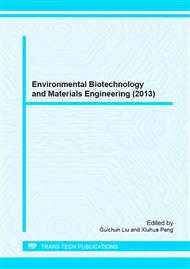[1]
H Jiapeng. Documents and historical materials of soy sauce production technology,. vol. 7, (2004).
Google Scholar
[2]
M Chengyu. Engineering design of sauce wastewater treatment,. Water supply and drainage. 11th ed, vol. 2, p.21~23, (1995).
Google Scholar
[3]
L Zhaoyuan. Production technology of soy sauce (b) - the classification and the main component of the soy sauce,. Chinese spices. Vol. 2, p.45~46, (2002).
Google Scholar
[4]
G Qunshun. Treatment technology of sauce wastewater,. Environmental Science and Technology. 26th ed, vol. 1, p.60~62, (2003).
Google Scholar
[5]
W Kaijun. Theory and engineering practice of the UASB process,. Beijing: China Environmental Science Press. p.16~21, (2000).
Google Scholar
[6]
Z Jinlong. The food industry production of wastewater treatment processes and process instances,. Chemical Industry Press, p.144~188, (2011).
Google Scholar
[7]
T Yu, Z Jinlong. Research on membrane bioreactor process of sauce wastewater treatment,. Environmental Sciences. 17th ed, vol. 6, (2004).
Google Scholar
[8]
F Hongyun. Brewing activated sludge water treatment method,. vol. 6, p.36 ~ 38, (1999).
Google Scholar
[9]
S Yaoliang, W Baozhen. Theory and application of wastewater bio-treatment,. Beijing: Chinese environmental science press, p.186~201, (2005).
Google Scholar
[10]
W Daxin, X Xinhua, S Shuang. Manual of specific pollutants treatment in industrial wastewater,. Beijing: chemical industry press, p.67~126, (2000).
Google Scholar
[11]
T Yu, L Min, Z Lei. Hydrolytic acidification-secondary SBR-floatation process treats wastewater of soy sauce,. Environmental engineering. 21st ed, vol. 2, p.27~38, (2003).
Google Scholar
[12]
Z Ke, B Qiuping, L Shaohong. Design and operation of wastewater treatment plant,. Beijing: chemical industry press, p.184~201, (2001).
Google Scholar
[13]
Z Xiao. Experimental study on corridor sewage treatment facilities deal with the soy sauce wastewater,. Beijing: China University of Geosciences, (2006).
Google Scholar
[14]
L Weidong, T Ribin, D Gang. Hydrolysis + jet aeration + the cinder adsorption process treatment,. Heilongjiang environmental informed. 27th ed, vol. 2, p.47 ~ 48, (2003).
Google Scholar
[15]
C Gavin, M Cousins, M. L. Menard, M. Atkinson, F. Khandwala, G. P. Kenny. Resistance exercise but not aerobic exercise lowers remnant-like lipoprotein particle cholesterol in type 2 diabetes: A randomized controlled trial,. Atherosclerosis, 2nd ed, vol. 213, pp.552-557, December (2010).
DOI: 10.1016/j.atherosclerosis.2010.08.071
Google Scholar


